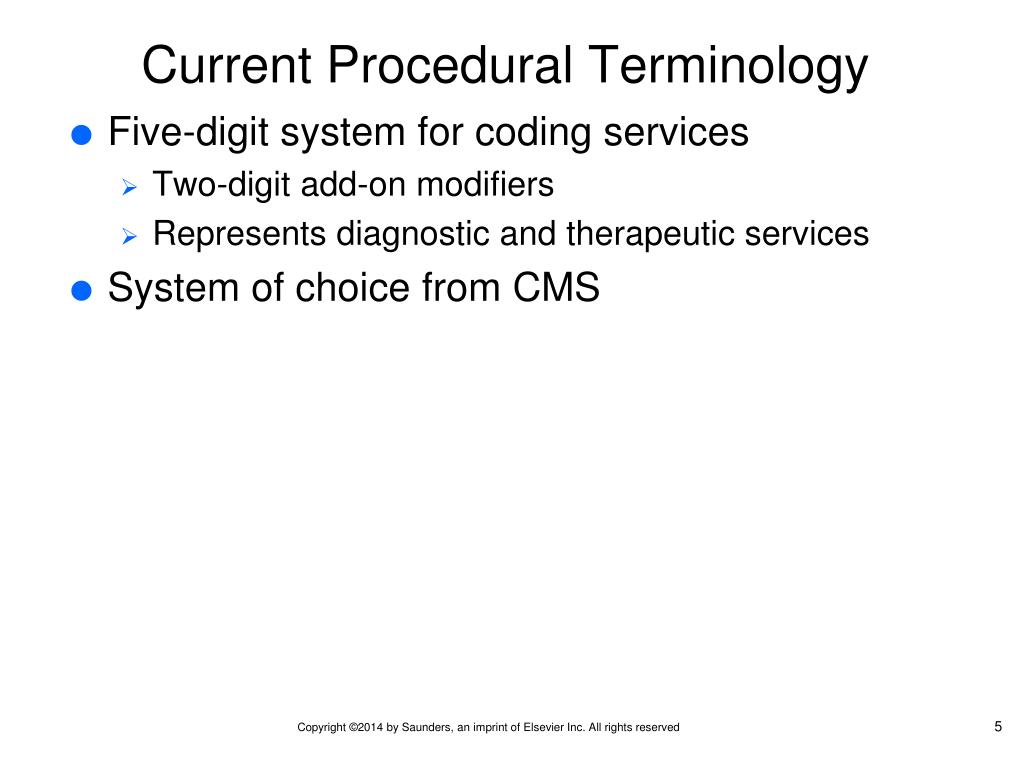

- CURRENT PROCEDURAL TERMINOLOGY CODEBOOK HOW TO
- CURRENT PROCEDURAL TERMINOLOGY CODEBOOK SKIN
- CURRENT PROCEDURAL TERMINOLOGY CODEBOOK PLUS
Your coder should report the case with CPT code 11402 ("Excision, benign lesion including margins, except skin tag (unless listed elsewhere), trunk, arms, or legs excised diameter 1.1 to 2.0 cm"). If a benign lesion of the trunk measures 1.0 cm and the margins required to adequately excise the lesion are 0.5 cm on both sides for a total margin of 1.0 cm, the physician should document 1.0 cm 0.5 cm 0.5 cm = 2.0 cm.

Thus, the excised diameter is the same whether the surgical defect is repaired in a linear fashion or reconstructed (such as by a skin graft).
CURRENT PROCEDURAL TERMINOLOGY CODEBOOK PLUS
The measurement of lesion plus margin is made prior to its actual excision. The previous description of the code was, "Excision, malignant lesion, trunk, arms, or legs lesion diameter 0.5 cm or less." In 2003, the code now reads, "Excision, malignant lesion including margins, trunk, arms, or legs, excised diameter 0.5 cm or less." This means that lesion diameter plus the narrowest margins required to adequately excise the lesion (based on the physician's judgment) equals the "excised diameter" referred to in the code. There's a new way to code excision of benign lesions (CPT codes 11400 ? 11446) and excision of malignant lesion (11600 ? 11646). Many specialties have new or revised 2003 codes that are causing confusion. The "simplified" modifiers aren't the only problem for ASCs. This is crucial for making sure your payers continue to reimburse your claims without holdups over the modifiers. If you have third-party payers that require the five-digit modifiers, confirm that they will now accept the two-digit modifiers and that they are aware that five-digit modifiers no longer "officially" exist. Not all payers have switched to the two-digit modifiers. For example, rather than using 09950 to report bilateral surgery, you now use a two-digit code (?50) for bilateral procedures. In a classic case of a good intention gone awry, the 2003 CPT codebook attempted to simplify modifier codes by replacing five-digit codes with two-digit codes.
CURRENT PROCEDURAL TERMINOLOGY CODEBOOK HOW TO
CPT® is a registered trademark of the American Medical Association.Confusion reigns over when and how to use some of the new and revised codes in the 2003 edition of the Physician's Current Procedural Terminology (CPT) code book and the 2003 HCPCS codes (Healthcare Common Procedure Coding System). Note: CPT Copyright 2021 American Medical Association.

If the GT modifier is billed by other provider types, the claim line will be rejected. As of January 1, 2018, the GT modifier is only allowed on institutional claims billed under Critical Access Hospital (CAH) Method II since institutional claims do not use a POS code. Medicare previously required providers to submit claims for telehealth services using the appropriate procedure code along with the telehealth GT modifier (“via interactive audio and video telecommunications systems”) or GQ modifier (“via an asynchronous (delayed communications) telecommunications system”). Guiding Principles for Industry Support.Young Investigators Research Forum (YIRF).Accredited Sleep Technologist Education Program (A-STEP).Advanced Practice Registered Nurses and Physician Assistants (APRN PA).


 0 kommentar(er)
0 kommentar(er)
